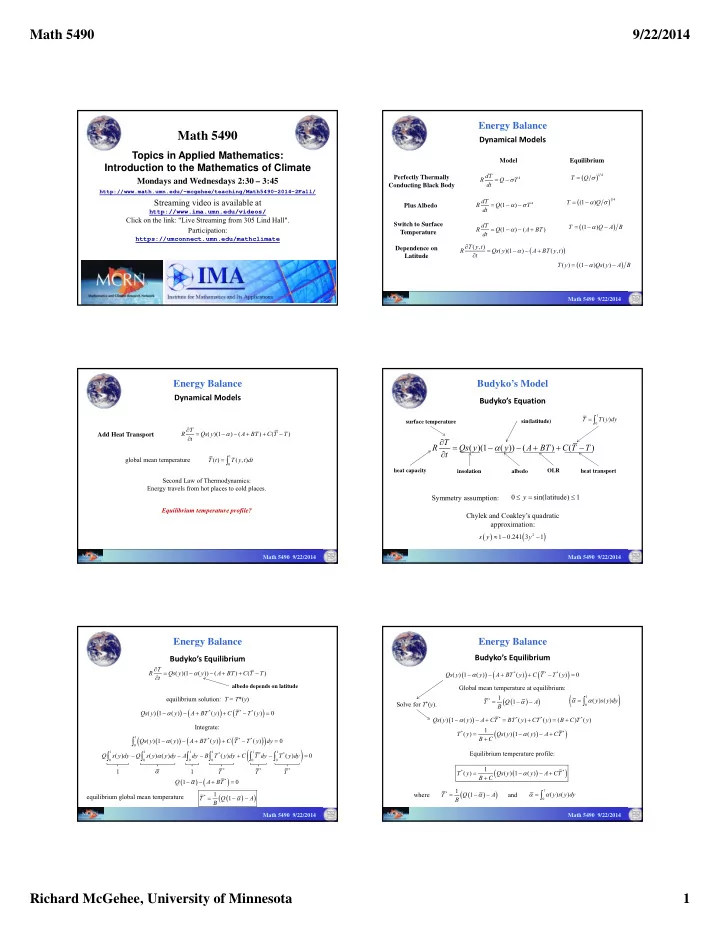

Math 5490 9/22/2014 Energy Balance Math 5490 Dynamical Models Topics in Applied Mathematics: Model Equilibrium Introduction to the Mathematics of Climate dT 1 4 T Q Perfectly Thermally R Q T 4 Mondays and Wednesdays 2:30 – 3:45 dt Conducting Black Body http://www.math.umn.edu/~mcgehee/teaching/Math5490-2014-2Fall/ dT 1 4 Streaming video is available at T (1 ) Q 4 R Q (1 ) T Plus Albedo dt http://www.ima.umn.edu/videos/ Click on the link: "Live Streaming from 305 Lind Hall". Switch to Surface dT T (1 ) Q A B R Q (1 ) ( A BT ) Participation: Temperature dt https://umconnect.umn.edu/mathclimate T y t ( , ) Dependence on R Qs y ( )(1 ) A BT y t ( , ) t Latitude T y ( ) (1 ) Qs y ( ) A B Math 5490 9/22/2014 Energy Balance Budyko’s Model Dynamical Models Budyko’s Equation 1 T T y dy ( ) surface temperature sin(latitude) 0 T R Qs y ( )(1 ) ( A BT ) C T ( T ) Add Heat Transport t T R Qs y ( )(1 ( )) y ( A BT ) C T ( T ) t 1 global mean temperature T t ( ) T y t dt ( , ) 0 heat capacity OLR insolation albedo heat transport Second Law of Thermodynamics: Energy travels from hot places to cold places. Symmetry assumption: 0 y sin(latitude) 1 Equilibrium temperature profile? Chylek and Coakley’s quadratic approximation: 2 s y 1 0.241 3 y 1 Math 5490 9/22/2014 Math 5490 9/22/2014 Energy Balance Energy Balance Budyko’s Equilibrium Budyko’s Equilibrium T R Qs y ( )(1 ( )) y ( A BT ) C T ( T ) Qs y ( ) 1 ( ) y A BT * ( ) y C T * T * ( ) y 0 t albedo depends on latitude Global mean temperature at equilibrium: 1 1 equilibrium solution: T = T *( y ) * ( ) ( ) y s y dy T Q 1 A Solve for T * ( y ). B 0 * * * Qs y ( ) 1 ( ) y A BT ( ) y C T T ( ) y 0 * * * * Qs y ( ) 1 ( ) y A CT BT ( ) y CT ( ) y ( B C T ) ( ) y Integrate: 1 T * ( ) y Qs y ( ) 1 ( ) y A CT * 1 B C Qs y ( ) 1 ( ) y A BT * ( ) y C T * T * ( ) y dy 0 0 1 1 1 1 1 1 Equilibrium temperature profile: * * * Q s y dy ( ) Q s y ( ) ( ) y dy A dy B T ( ) y dy C T dy T ( ) y dy 0 0 0 0 0 0 0 1 1 1 T * T * T * * * T ( ) y Qs y ( ) 1 ( ) y A CT B C Q 1 A BT * 0 1 1 1 where T * Q 1 A and ( ) ( ) y s y dy equilibrium global mean temperature * T Q 1 A B 0 B Math 5490 9/22/2014 Math 5490 9/22/2014 Richard McGehee, University of Minnesota 1
Math 5490 9/22/2014 Energy Balance Energy Balance Budyko’s Equilibrium Budyko’s Equilibrium * * * Qs y ( ) 1 ( ) y A BT ( ) y C T T ( ) y 0 60 1 Equilibrium temperature profile: T * ( ) y Qs y ( ) 1 ( ) y A CT * 40 B C 60 temperature (Celsius) 20 ice free 40 0 temperature (Celsius) snowball 20 ice free C = 3.04 ‐ 20 0 ice free (C=0) α ( y ) = 0.32: ice free snowball α ( y ) = 0.62: snowball ‐ 20 ‐ 40 snowball (C=0) ice free (C=0) (constant albedo) ‐ 40 snowball (C=0) ‐ 60 ‐ 60 ‐ 80 ‐ 80 0 0.2 0.4 0.6 0.8 1 ice won’t melt ice will form 0 0.2 0.4 0.6 0.8 1 sin(latitude) (no exit from snowball) (icecap) sin(latitude) Math 5490 9/22/2014 Math 5490 9/22/2014 Budyko’s Model Budyko’s Model Ice Albedo Feedback Ice Albedo Feedback M. I. Budyko, "The effect of solar radiation variations on the climate of the Earth," Tellus XXI , 611-619 , 1969. temperature warms temperature warms ice melts ice melts albedo decreases albedo decreases more sunlight absorbed more sunlight absorbed temperature warms temperature warms REPEAT REPEAT Why would it stop? Why would it stop? http://www.inenco.org/index_principals.html http://www.i-fink.com/melting-polar-ice/ Math 5490 9/22/2014 Math 5490 9/22/2014 Budyko’s Model Budyko’s Model Ice Albedo Feedback Ice Albedo Feedback What if the albedo is not constant? Why would it stop? Ice Line Assumption: There is a single ice line at y= η between the equator Budyko’s Equation and the pole. The albedo is α 1 below the ice line and α 2 above it. y ( , ) y 1 and 1 T T y dy ( ) y surface temperature sin(latitude) 0 2 Equilibrium condition: * * * Qs y ( ) 1 ( , ) y A BT ( ) y C T T ( ) y 0 T R Qs y ( )(1 ( )) y ( A BT ) C T ( T ) t Equilibrium solution: 1 T * ( ) y Qs y ( ) 1 ( , ) y A CT * heat capacity OLR insolation albedo heat transport B C 1 where 1 T * Q 1 ( ) A ( ) ( , ) ( ) y s y dy B 0 Math 5490 9/22/2014 Math 5490 9/22/2014 Richard McGehee, University of Minnesota 2
Recommend
More recommend